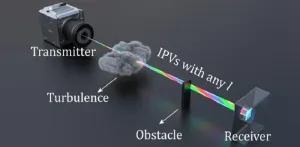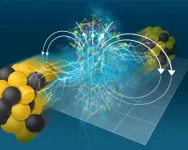(Press-News.org) Atrial fibrillation (AF) is the most common form of arrythmia or irregular heartbeat worldwide, impacting millions of people in the U.S. alone. In a new study published in Heart Rhythm, researchers from Brigham and Women’s Hospital, a founding member of the Mass General Brigham healthcare system, analyzed real-world clinical data to measure the impact of evidence-based best-practices on patient outcomes for the most common AF procedure: radiofrequency (RF)-based ablation. One year after the procedure, 81.6 percent of patients were free from atrial arrhythmias, higher than rates reported from clinical trials, and 89.7 percent of these patients were off antiarrhythmic drugs. Results were presented simultaneously at a late-breaking clinical trial presentation at the Heart Rhythm 2024 meeting in Boston, MA.
“When we incorporate what we think are the best strategies for radiofrequency-based ablation, we can further improve the long-term patient outcomes,” said corresponding author Paul Zei, MD, an electrophysiologist and physician-researcher at Brigham and Women’s Hospital. “With high-volume experienced operators using these best practices, we are reporting excellent short and long-term clinical outcomes, with more than 80% long-term success and very low complication rates.”
RF-based ablation uses radiofrequency energy to inactivate the heart tissue responsible for producing irregular electrical signals. Though RF-based ablation’s safety and efficacy have been previously demonstrated in randomized, controlled clinical trials, the technique is ever evolving, and little is known about the effectiveness and safety of the technique outside of clinical trials.
The study used data from the REAL-AF registry, a multi-center registry that Zei co-founded in 2019 to evaluate long-term outcomes and clinical management in patients treated for AF. The registry consists of over 50 centers that regularly perform a high volume of RF-ablation procedures and who conform to contemporary best-practice techniques—including a focus on isolating the pulmonary vein, reducing or eliminating the use of fluoroscopy during the procedure, and using a shorter but higher blast of radiofrequency to reduce procedural time.
“We studied experienced operators and centers to try to ensure that we were studying the best techniques that are already being used,” Zei said. “Our motivation is to learn the best approaches for RF-based ablation and adjust and improve those approaches so that our outcomes get even better.”
The researchers evaluated data from 2,470 patients in the REAL-AF registry who had undergone RF-based ablation for paroxysmal AF, the form of AF in which symptoms come and go. For each patient, the team evaluated procedure time and technique, and examined patient outcomes immediately after the procedure and 12 months later.
Zei’s team reports that procedures in the REAL-AF registry are more efficient, safe, and effective compared to data from randomized clinical trials. At one-year follow-up, freedom from all-atrial arrhythmia and AF were 81.6 percent and 85.7 percent, respectively. Moreover, 93.2 percent of patients reported no arrhythmia symptoms during the follow-up period. Average procedure time was also significantly shorter, which improves patient safety by reducing time under anesthesia and means that hospitals and operators can perform more of these high-demand procedures.
Going forward, the researchers plan to continue to refine RF-ablation procedure for both paroxysmal AF, the focus of this study, and persistent AF.
“It's an ongoing endeavor,” said Zei. “An important next step will be to apply similar strategies to try to understand how this procedure can be improved for patients with the persistent type of AF, which is more difficult to treat than paroxysmal AF.”
In the future, Zei says that the registry model used in this study could be easily adapted to optimize other medical procedures in electrophysiology and beyond.
“As well as being a study, the registry is a learning health network. We’re not only evaluating the best approach for RF-based ablation; we're also learning from each other,” Zei said. “The goal is to disseminate best practices across every operator and center.”
Authorship: In addition to Zei, BWH authors include Andres F. Miranda-Arboleda, Carolina Hoyos, and Jorge E. Romero. Other authors include Jose Osorio, Alejandro Velasco, Allyson L. Varley, Anil Rajendra, Gustavo X. Morales, Christopher Thorne, Benjamin D’souza, Joshua R. Silverstein, Mark D. Metzl, Shrinivas Hebsur, Alexandru I. Costea, Steven Kang, Matthew Sellers, David Singh, Tariq Salam, Jose Nazari, Alex S. Ro, Sean Mazer, Antonio Moretta, Saumil R. Oza, Anthony R. Magnano, Jonathan Dukes, Sandeep K. Goyal, Todd Senn, David Newton,
Disclosures: Dr. Jose Osorio and Dr. Paul C. Zei have received consulting and research support from Biosense Webster. Christopher Thorne and Allyson L. Varley received funding through Biosense Webster. Dr. Joshua R. Silverstein declared consulting/Honoraria - Medtronic, Biosense Webster, impulse dynamics. Dr. Saumil R. Oza serves as an advisory board and consultant for Biosense Webster. Dr. Mark D. Metzl consults for Attune Medical, Biosense Webster, Abbott, Medtronic, Philips, and Sanofi. Dr. Jorge E. Romero is a consultant for Biosense Webster, Boston Scientific, AtriCure, Abbott, and Sanofi. Sandeep K. Goyal is a consultant for Biosense Webster and Medtronic. Dr. Bejamin D’Souza is a consultant for BiosenseWebster. Dr. Jonathan Dukes has received research, speaking, and consulting honoraria from Biosense Webster, from Medtronic research and consulting, Biotronik speaking research and consulting, and Boston Scientific research and consulting. Dr. Anil Rajendra received consulting fees from Biosense Webster and Boston Scientific. Dr. Tariq Salam is a paid consultant for Biosense Webster.
Funding: Funding for this registry was provided by Biosense Webster, Inc.
Paper cited: Osorio, J & Miranda-Arboleda, A et al. “Real-World Data of Radiofrequency Catheter Ablation in Paroxysmal Atrial Fibrillation: Short- and Long-term Clinical Outcomes from the Prospective Multicenter REAL-AF Registry” Heart Rhythm
###
About Mass General Brigham
Mass General Brigham is an integrated academic health care system, uniting great minds to solve the hardest problems in medicine for our communities and the world. Mass General Brigham connects a full continuum of care across a system of academic medical centers, community and specialty hospitals, a health insurance plan, physician networks, community health centers, home care, and long-term care services. Mass General Brigham is a nonprofit organization committed to patient care, research, teaching, and service to the community. In addition, Mass General Brigham is one of the nation’s leading biomedical research organizations with several Harvard Medical School teaching hospitals. For more information, please visit massgeneralbrigham.org.
END
Wireless implantable cardioverter-defibrillators (ICDs) eliminate the lead-related complications that come with a wired ICD, but they are unsuitable for patients with ventricular tachycardia, when the heart beats too quickly, or bradycardia, when the resting heart rate is seen as low. Research led by Amsterdam UMC, that is published today in the New England Journal of Medicine, shows that the first wireless modular system suitable for these patient groups is safe and exceeds performance expectations. Opening the door for a wider ...
WASHINGTON, DC (May 18, 2024) — Patients seen by a female gastroenterologist for an initial consultation are less likely to use medical care in the emergency department, hospital or primary care office for two years after their visit when compared to patients initially seen by male gastroenterologists, according to a study to be presented at Digestive Disease Week® (DDW) 2024.
“If there really is something different about the way female and male gastroenterologists provide care that impacts patient outcomes, it will be important to share these learnings broadly among health care providers ...
The future of optical communications just got brighter. In a groundbreaking development reported in Advanced Photonics, researchers from Nanjing University have introduced iso-propagation vortices (IPVs), a novel concept that offers a solution to a long-standing challenge faced by scientists and engineers: how to increase information processing capacity while overcoming the limitations of traditional vortex beams.
Challenge: divergence and beam size
Multiplexing of optical degrees of freedom, such as polarization and wavelength, has been a staple in enhancing communication capacity. ...
On a cold winter night in 2016, Ukrainians experienced the first-ever known blackout caused by malicious code (malware) designed to autonomously attack the power grid. One-fifth of Kyiv’s citizens were plunged into darkness as attackers used malware to target the capital city’s power grid. Six years later, in the early months of the ongoing Russia-Ukraine war, a second attack attempted to combine kinetic and cyber attacks to take down Ukraine’s power grid.
Malware attacks against physical ...
“Practice makes perfect” is no mere cliché, according to a new study from researchers at The Rockefeller University and UCLA. Instead, it’s the recipe for mastering a task, because repeating an activity over and over solidifies neural pathways in your brain.
As they describe in Nature, the scientists used a cutting-edge technology developed by Rockefeller’s Alipasha Vaziri to simultaneously observe 73,000 cortical neurons in mice as the animals learned and repeated a given task over two weeks. The study revealed that memory representations transform from unstable to solid in ...
New initiative, launched on World NF Awareness Day, focuses on developing improved models to understand neurofibromatosis type 1 (NF1) with the goal of rapidly testing new treatments.
18 grants will be provided to leading medical research institutions in the United States and Europe.
The Next-Generation NF1 Models Initiative is the Foundation’s fourth research initiative focused on accelerating a cure for neurofibromatosis.
DETROIT, May 17, 2024 – Gilbert Family Foundation, a private foundation established by Dan and Jennifer Gilbert to accelerate a cure for ...
About The Study: This study found that BRCA1-associated protein (BAP1) tumor predisposition syndrome was associated with a high rate of nail abnormalities consistent with onychopapillomas (a benign tumor of the nail) in adult carriers of the disease. Findings suggest that this novel cutaneous sign may facilitate detection of the syndrome in family members who are at risk and patients with cancers associated with BAP1 given that multiple onychopapillomas are uncommon in the general population and may be a distinct clue to the presence of a pathogenic germline variant in the BAP1 gene.
Corresponding Authors: To contact the corresponding authors, ...
The silver chub isn’t considered sensitive to climate change on a national scale, but context matters. For example, if climate change sensitivity is evaluated in only one region of the United States, the freshwater fish appears quite a bit more susceptible.
“Relative to other species we looked at in the gulf region of the U.S., the silver chub occupied a pretty small geographic area,” said Samuel Silknetter, a Ph.D. student in biological sciences. “If we didn’t look at the climate sensitivity across multiple ...
PHILADELPHIA (May 16, 2024) – The rich research portfolio of the Monell Chemical Senses Center on sweet taste goes way back: Monell scientists were one of four teams in 2001 that found and described the mammalian sweet taste receptor – TAS1R2-TAS1R3. Twenty years later in 2021, a pair of papers published in Mammalian Genome by Monell researchers covered the genetics of sugar-loving mice.
The sweet taste receptor, expressed in taste bud cells, conveys sweetness from the mouth when it is activated. Earlier this month, a study in PLOS One, led by another Monell researcher, delved into how the sweet-taste receptor might be the first stop ...
The Science
Scientists have the first direct evidence that the powerful magnetic fields created in off-center collisions of atomic nuclei induce an electric current in “deconfined” nuclear matter. This is a plasma “soup” of quarks and gluons that have been set free, or “deconfined,” from nuclear matter—protons and neutrons—in the particle collisions. The magnetic fields in deconfined nuclear matter are a billion times stronger than a typical refrigerator magnet, but their effects can be hard to detect. This new study’s evidence is from measuring the way ...



